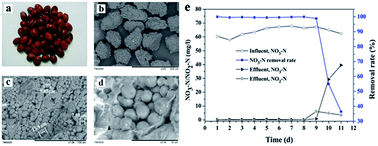Biological denitrification in high salinity wastewater using semen litchi as a carbon source
Abstract
A new agricultural waste semen litchi was used as the sole carbon source to remove nitrate from high salinity wastewater in laboratory reactors. The main nutrient components, the content of heavy metals and the morphology of semen litchi were first studied. The results showed that semen litchi contained about 60% organic carbon and low levels of heavy metals. The milled semen litchi had lots of gap structures and abundant starch granules. Then the release velocity of the carbon source and the denitrification rate in high salinity wastewater were investigated. It was found that semen litchi could supply continuous organic carbon for denitrification. And the maximum TOC concentration could reach 137.29 mg l−1 on the 46th day. The nitrate removal rate and denitrification rate could reach 98.8–99.5% and 192 mg N (l−1 d−1), respectively. During the whole denitrification reaction, the nitrite concentration was lower than 0.01 mg l−1. A microbial community profile by Polymerase Chain Reaction-Denaturing Gradient Gel Electrophoresis (PCR-DGGE) indicated that the denitrifying bacteria (Sphingomonas family and Rhodospirillum family) became enriched in the semen litchi sludge. Furthermore, salinity didn't have a negative effect on denitrification. Semen litchi could be used as an economical and effective carbon source for denitrification in high salinity wastewater.


 Please wait while we load your content...
Please wait while we load your content...